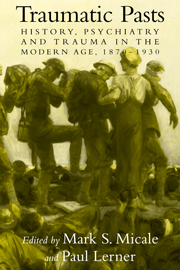Book contents
- Frontmatter
- Contents
- Contributors
- Preface
- 1 Trauma, Psychiatry, and History: A Conceptual and Historiographical Introduction
- Part One Travel and Trauma in the Victorian Era
- Part Two Work, Accidents, and Trauma in the Early Welfare State
- Part Three Theorizing Trauma: Psychiatry and Modernity at the Turn of the Century
- Part Four Shock, Trauma, and Psychiatry in the First World War
- 9 “Why Are They Not Cured?” British Shellshock Treatment During the Great War
- 10 Psychiatrists, Soldiers, and Officers in Italy During the Great War
- 11 A Battle of Nerves: Hysteria and Its Treatments in France During World War I
- 12 Invisible Wounds: The American Legion, Shell-Shocked Veterans, and American Society, 1919–1924
- Index
- Titles in the series
10 - Psychiatrists, Soldiers, and Officers in Italy During the Great War
Published online by Cambridge University Press: 14 October 2009
- Frontmatter
- Contents
- Contributors
- Preface
- 1 Trauma, Psychiatry, and History: A Conceptual and Historiographical Introduction
- Part One Travel and Trauma in the Victorian Era
- Part Two Work, Accidents, and Trauma in the Early Welfare State
- Part Three Theorizing Trauma: Psychiatry and Modernity at the Turn of the Century
- Part Four Shock, Trauma, and Psychiatry in the First World War
- 9 “Why Are They Not Cured?” British Shellshock Treatment During the Great War
- 10 Psychiatrists, Soldiers, and Officers in Italy During the Great War
- 11 A Battle of Nerves: Hysteria and Its Treatments in France During World War I
- 12 Invisible Wounds: The American Legion, Shell-Shocked Veterans, and American Society, 1919–1924
- Index
- Titles in the series
Summary
In each of the belligerent countries of the Great War, military trauma, emotional suffering, and daily exposure to violence and death caused mental distress beyond all expectations. Psychiatrists in each country were called on to observe, select, and cure, and were forced to re-examine their views of mental illness in light of the war experiences. Italian psychiatrists, who since 1915 had taken a unified stance in favor of intervention, held positions of authority during the war both within the military and in society as a whole: Augusto Tamburini, president of the psychiatric society, was in charge of the neuropsychiatric service in the army; Leonardo Bianchi, professor of psychiatry in Naples, was minister without portfolio responsible for the coordination of war health services; and Enrico Morselli headed an important section of the Union of Italian Doctors for National Resistance.
The Italian debate on the nature and treatment of war neuroses was directly influenced by the role of psychiatry in national mobilization, by the tendencies that dominated psychiatric thought and practice, and also by the social and political tensions caused by the war. Italy, of course, was the only Western European country to enter the war without mass consensus; indeed, the war, although fought with persistent aggression until the end of 1917, never met with support from the Italian people, who maintained a consistently hostile attitude. Italy's intervention was, in fact, forced on the country by a small political elite that sought economic and territorial expansion and the restoration of domestic authoritarianism.
- Type
- Chapter
- Information
- Traumatic PastsHistory, Psychiatry, and Trauma in the Modern Age, 1870–1930, pp. 222 - 252Publisher: Cambridge University PressPrint publication year: 2001
- 4
- Cited by

